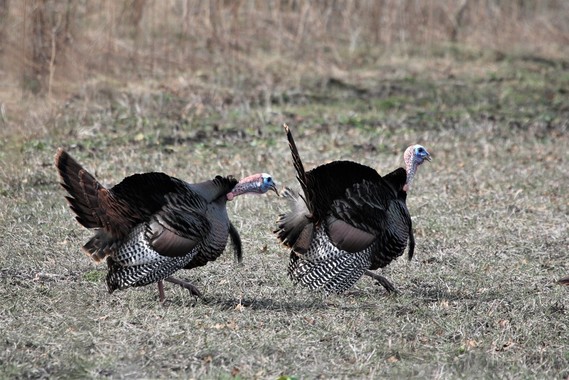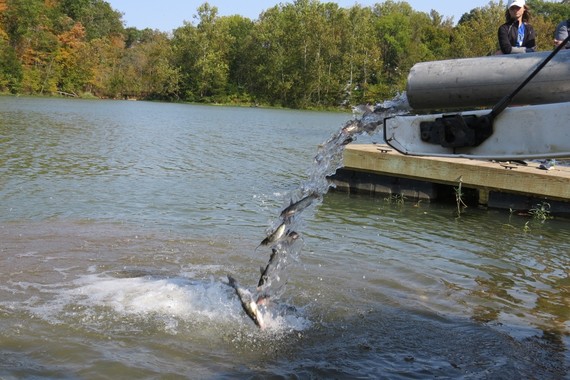|
Chris Peabody, 2020 FIsh of the Year Winner, Brown Trout
It’s time to renew your fishing license
Spring is finally here, which for many people means it is time to fish. Before heading out, remember that 2021-2022 fishing licenses expired on March 31. To renew yours for the 2022-2023 season or purchase one for the first time, visit on.IN.gov/INhuntfish or a local retailer. Your participation helps the Division of Fish & Wildlife increase access, create healthier habitats, and provide more rewarding experiences for anglers across the state.
Find fishing tips and videos on our website.
 Are you excited to start chasing gobbles?
Spring wild turkey season begins for adult hunters April 27 and continues through May 15. Youth season for spring wild turkey hunting is April 23-24. Hunters need a valid turkey hunting license and game bird habitat stamp to participate.
Find the Where to Hunt Map, regulations, spring harvest data, processing videos, and more on our website.
Standby draws
If you were not successful drawing a reserved hunt spot for the 2022 spring turkey season, there are still opportunities to get out and hunt on Indiana’s public lands. One of those options is standby draws. Here’s how they work:
Fish & Wildlife areas (FWAs) often allocate spring turkey hunting opportunities through a reserved hunt draw. Hunters drawn for a reserved hunt must claim their spots daily by a certain time each morning, or that hunting opportunity will be included in the standby draw. Non-reserved hunters who hold a valid turkey hunting license and game bird stamp may sign up for standby draws each morning for a chance at one of the unclaimed spots. Remember, these spots can only be claimed in person, and there is no guarantee there will be openings available. Hunters interested in participating in turkey hunt standby draws should contact the property they wish to hunt for more information regarding draw times and procedures.
May 1 is this year’s first Free Fishing Day

Indiana residents do not need a fishing license to cast a line and get out on the water on these special days. Free fishing days are a great opportunity to relax with family and friends, de-stress, and plan a picnic. There are many free, publicly accessible fishing spots throughout Indiana. Check out the Where to Fish page to find your next favorite fishing hole.
|
Propeller with zebra muscles, courtesy of Stop Aquatic Hitchhikers
Prevent the spread of aquatic invasive species
As you prepare your boat or recreational equipment to get back on the water this spring, remember to look for aquatic hitchhikers. Zebra mussels, aquatic plants like Eurasian watermilfoil or starry stonewort, and many other invasive species continue to be a threat to Indiana’s waters by degrading fish habitat and negatively affecting recreational boating and fishing. The most common locations where plants, mussels, and animals hitch a ride include:
- Transom well near the drain plug
- Axle of the trailer
- Lower unit and propeller on the boat motor
- The rollers and bunks that guide the boat onto the trailer
- Anchor and lines
- Bait bucket and live well
Boat owners are asked to drain water from bait buckets, live wells, and boats before leaving the boat landing; leave drain plugs out while travelling on land; clean and dry anything that came in contact with water; and dispose of unwanted bait in the trash. Learn more about aquatic invasive species and how to prevent their movement.
Mute swan population growth affects Indiana habitat
Mute swans (Cygnus olor) are an invasive species that has become established in high numbers on many bodies of water in Indiana. As the mute swan population has expanded over the last few decades, so has the habitat destruction attributed to their presence. An adult mute swan consumes up to eight pounds of aquatic and wetland vegetation per day and during nest building can destroy large areas of wetland vegetation. These disturbances can have a serious impact on water quality, aquatic habitat for fish and wildlife, and wetland functions. Mute swans can also be extremely aggressive toward people, pets, and native wildlife, especially during nesting and the rearing of young. If your community is having concerns with mute swans, explore ways you can reduce their impacts.
 Where do baby fish come from?
DNR annually stocks fish throughout the state to improve fishing. Many of these fish are raised at one of the state’s seven hatcheries. To peek behind the scenes at a hatchery, check out this video. To learn which fish have been stocked in your favorite lake, poke around in the fish stocking database.
Keep calm – it’s time for baby animals

The emergence of spring means young wildlife will begin appearing throughout Indiana, from our state’s forests to your own backyard. If you encounter a young wild animal that appears to have been left alone, keep calm. Adult wild animals rarely abandon their young and will likely return after gathering food for the family. Check back periodically on the young animal and look for signs that an adult has been attending to them, but don’t hover. If the found animal is in a nest, you can pour a ring of flour around it to help you determine if an adult animal has returned while you were away.
If the animal you find is injured or in distress (bleeding, weak, covered in flies, has broken bones), contact a wildlife rehabilitator instead of trying to care for the animal yourself. Wild animals require different care than domesticated pets. Wildlife rehabilitators are trained and permitted to care for many different wild species. They will be equipped to care for the animal while allowing it to retain its natural fear of humans so it can return to and survive in the wild.
|
 |
Get outside to Fish & Wildlife areas

Are you suffering from cabin fever after another long, cold winter? The cure is to connect with nature. April in Indiana is a great time to get outside to catch glimpses of spring. Observing plants and wildlife during their periods of transition is an excellent way to deepen your understanding of nature. From the first wildflowers coming up through the ground to migrating birds returning to greet warmer temperatures, the opportunities to see something new are all around you every day. Find a spot to watch spring unfold near you.
|
 40 years, 40 stories
The Nongame Wildlife Fund turns 40 this year. Learn about the accomplishments made possible by donors, partners, and volunteers by following its StoryMap and signing up for the Nongame Wildlife Fund Newsletter. For instructions on how to donate on your state taxes, watch this video or donate directly online.
Recent news releases
Share thoughts on fisheries with DNR on angler survey
Channel catfish stocked in urban fishing lakes
J.C. Murphey Lake renovations
LARE grants awarded for sediment or logjam removal and aquatic invasive plant control
Public Notices
Shovel Pit East public access site
Shovel Pit West public access site
Waverly public access site
Bear Lake public access site
Otter Lake public access site
Pretty Lake public access site
Shelbyville public access site
Webster Lake Backwater public access site
|